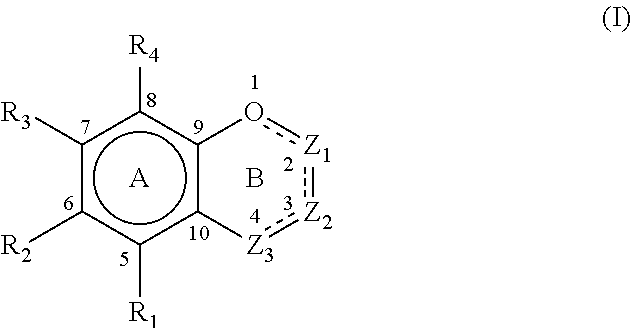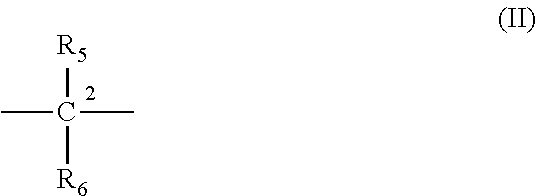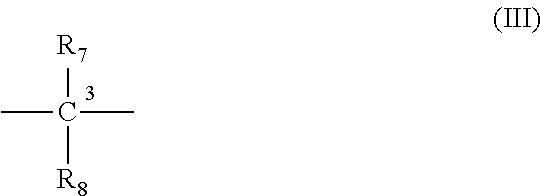Stable catalysts for electroless metallization
a precious metal catalyst and electroless metallization technology, applied in the direction of metal/metal-oxide/metal-hydroxide catalysts, physical/chemical process catalysts, chemical coatings, etc., can solve the problems of increasing the cost of palladium, colloid cannot maintain its colloidal structure, and many disadvantages, so as to reduce or eliminate interconnect defects and good metal coverage of the substrate
- Summary
- Abstract
- Description
- Claims
- Application Information
AI Technical Summary
Benefits of technology
Problems solved by technology
Method used
Image
Examples
example 1
[0046]190 mg naringin dihydrate was dissolved in a beaker containing 750 ml of DI water. The water was heated to 50° C. to assist in dissolving the naringin dihydrate. 290 mg Na2PdCl4 in 25 ml of DI water was added to the solution of naringin with stirring to form a substantially uniform orange colored solution. 93 mg NaBH4 in 10 ml of DI water was added to the substantially uniform solution with vigorous stir bar agitation. The solution changed in color from orange to black indicating the formation of colloidal palladium nanoparticles. The molar ratio of palladium metal to naringin was 1:0.3. The beaker containing the aqueous colloidal naringin and palladium nanoparticles was then placed in a 50° C. water bath for 12 hours to test the shelf-life stability of the nanoparticles. The pH was monitored over the 12 hour period with an ACCUMET AB15 pH meter and fluctuated from 7 to 9 due to the formation of H2 gas and hydroxide in solution from the excess NaBH4. There was no observable bl...
example 2
[0048]190 mg naringin dihydrate was dissolved in a beaker containing 750 ml of DI water. The water was heated to 50° C. to assist in dissolving the naringin dihydrate. 440 mg Na2PdCl4 in 25 ml of DI water was added to the solution of naringin with stirring to form a substantially uniform orange colored solution. 140 mg NaBH4 in 10 ml of DI water was added to the substantially uniform solution with vigorous stir bar agitation. The solution changed in color from orange to black indicating the formation of colloidal palladium nanoparticles. The molar ratio of palladium metal to naringin was 1:0.2 and the pH of the bath was between 8 and 9. The beaker containing the aqueous colloidal palladium nanoparticles was then placed in a 50° C. water bath for 12 hours to test the stability of the nanoparticles. There was no observable formation of black precipitate at the bottom of the beaker. The colloidal nanoparticles were stable over the 12 hour period.
example 3
[0049]Two sample aliquots of equal volume of the naringin / palladium colloidal nanoparticle catalyst made in Example 2 were removed from the stock solution and diluted with DI water such that the concentration of the palladium in each sample was 50 ppm. A sufficient amount of 2,4-dihydroxybenzoic acid was added to one sample to adjust the pH to 3 and the other sample had its pH adjusted to 3 by adding sufficient amounts of glyoxylic acid.
[0050]The naringin / palladium colloidal nanoparticle samples were tested for copper electroless plating performance on two sets of six different laminates: TUC-662, SY-1141, SY-1000-2, IT-158, IT-180 and NPG-150. IT-158 and IT-180 were obtained from Taiwan ITEQ Corporation, NPG-150 was from Nanya Corporation, TUC-662 was obtained from Taiwan Union Technology Corporation and SY-1141 and SY-1000 were obtained from Shengyi. The Tg values ranged from 140° C. to 180° C. Each laminate was 5 cm×12 cm and had a plurality of through-holes. A surface of each la...
PUM
| Property | Measurement | Unit |
|---|---|---|
| size | aaaaa | aaaaa |
| size | aaaaa | aaaaa |
| size | aaaaa | aaaaa |
Abstract
Description
Claims
Application Information
 Login to View More
Login to View More - Generate Ideas
- Intellectual Property
- Life Sciences
- Materials
- Tech Scout
- Unparalleled Data Quality
- Higher Quality Content
- 60% Fewer Hallucinations
Browse by: Latest US Patents, China's latest patents, Technical Efficacy Thesaurus, Application Domain, Technology Topic, Popular Technical Reports.
© 2025 PatSnap. All rights reserved.Legal|Privacy policy|Modern Slavery Act Transparency Statement|Sitemap|About US| Contact US: help@patsnap.com



